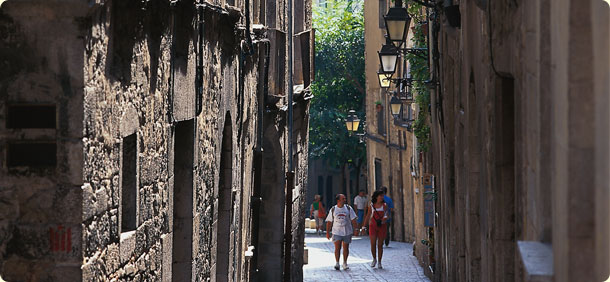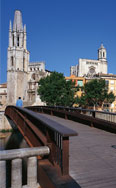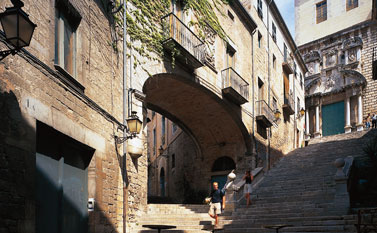- Villa search

- Canaries
- Caribbean
- Croatia, Bulgaria and Hungary
- Cyprus
- Florida
- France and Corsica
- Greece
- Italy
- Lakes and Mountains
- Madeira
- Malta and Gozo
- Portugal
- South Africa
- Spain - Balearics

Mediaeval street
Gateway to history

Think you might want a day away from the pool and the beach during your villa holiday on the Costa Brava? Try a day in Girona, says
Paul GogartyIt’s known as the ‘Gateway to Spain’, but most tourists crossing the border at Perpignan have taken the soubriquet literally, speeding past Girona on the E15 motorway in a dash for the coast.

Bridge over the Onyar
Holidaymakers flying into its airport treat the city just as brusquely, dispatching themselves by the busload to the Costa Brava’s beaches and only returning for their flight home.
I discovered Girona 15 years ago when researching a book on Catalonia but on my present visit I had just two nights to savour one of the Europe’s most atmospheric cities.
First evening
I strolled aimlessly through the old city and found the pulse still reassuringly slow despite the influx of students who have moved in since Girona University opened a decade ago.Apart from a handful of new art galleries and bars, the atmosphere remains overwhelmingly musty-mediaeval with each stone whispering a tale of persecution, martyrdom or heroic resistance.
During the day, the Rambla de la Libertat is bathed in sunlight and Gironins sit with all the time in the world at terraced cafés drinking coffee. But at night wrought iron lamps glow in front of the Gothic arcade like the menorahs of the countless Jews persecuted or expelled from the city. Pollarded lime trees join hands in the air, ghosts of the Civil War dancing a victory sardana – the Catalan national dance.
As I tread the cobbled streets a delicious eeriness descends that more feted European mediaeval cities such as Bruges can only dream of. More often than not I find I have the street to myself, the darkness relieved only by coach lamps abutting the walls that rake the huge wooden doors and send shadows chasing down alleys.

A street scene
home | destinations and editorial | villa search | property for sale | car hire | flights | services
villaseek blog | contact villaseek | links and resources | advertise your villa© Dune Root Ltd and Villaseek.com 2012 - Caribbean
- Canaries